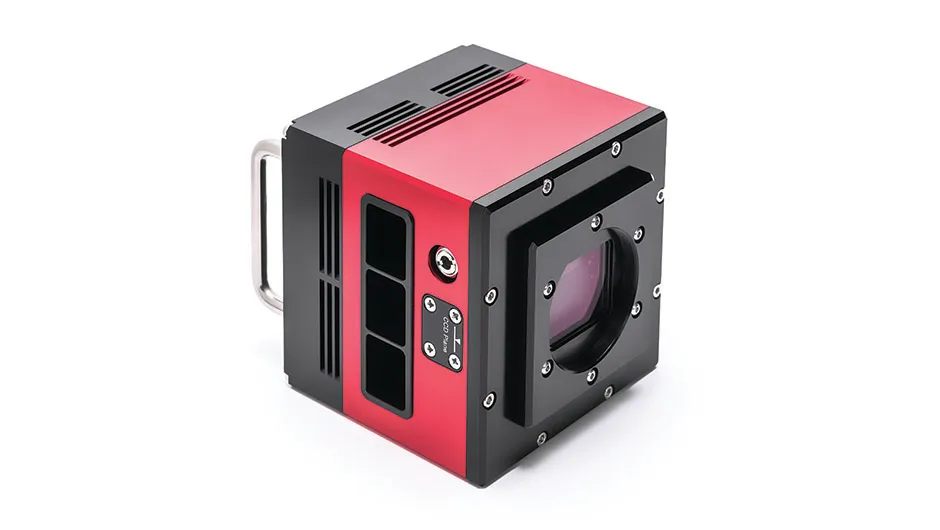Anyone familiar with the Atik range of astronomy cameras might be forgiven for not recognising the 16.2-megapixel Atik 16200 as being part of the family.Apart from the metallic red livery, this camera has been designed from the outset to be different, and yet it maintains the reliability and usability synonymous with the Atik name.
There’s no getting around the fact that the Atik 16200’s cube design makes it both large and relatively heavy, though there are handles on the rear of the camera body to help you attach it to a setup and fit accessories.
As this is a mono camera, we fitted our own filter wheel plus colour filters to the front, these being necessary to create colour images.
A one-shot-colour variant of the camera is available.Such a large casing has advantages, however – in this case a huge heat sink and fan fitted to the dual-stage electronic cooling system.
Astronomy cameras produce much cleaner images if the camera sensor is chilled, and the Atik 16200 aims to provide cooling capability up to 50°C below ambient temperature.
Keen to test this, we set the cooling to maximum and watched the readout as the temperature fell.
Within five minutes the sensor had been cooled from 10°C to –37°C, and the camera held that temperature steadily.
Preventing condensation in the rest of the camera interior is another concern, and problems can occur in some designs with rapid temperature drops.
In the 16200 Atik has neatly avoided issues with frosting and dew on the sensor chamber by sealing the camera body and purging it with argon gas, via an unobtrusive valve fitted to the side of the camera.
We watched carefully for any problems with the CCD frosting as it cooled, and there were none.

Cool performer
Impressive cooling aside, we wanted to see how the camera performed when pointed at the sky.
Each full-size image takes around 18 seconds to download via the USB 2.0 connection – something that prolongs the framing and focusing process slightly.
Once set, we aimed for NGC 281, the Pacman Nebula in Cassiopeia, and took a series of 30-minute exposures using a narrowband filter, a useful workaround given that there was a bright Moon around.
We were pleased to see that our images showed little noise over the long exposures.A few small, squiggly and random artefacts were present, but these were easily removed by stacking multiple images.
There was no sign of star bloating, and good overall response to the available signal from the target.
Subsequent exposures of varying lengths and through a range of filters demonstrated nicely that the custom electronics within the camera work efficiently with the sensor to produce smooth, clean images.
After stacking and processing, we discovered that the camera had picked up a wealth of faint detail, including emission and reflection nebulosity.
In addition to the reassuring hum of the cooling fan, each exposure produces an audible click, indicating the operation of the mechanical shutter.
With large sensors such as this one, taking reliable flat frames is normally an essential part of the imaging process; the shutter meant that we had to alter our standard method of taking flat calibration images, as short exposures left a trace of the mechanism in action on the image.
Eventually we settled on a method using a dimly lit white panel.
The minimum possible exposure of 0.2 seconds limits the camera to photographing deep-sky objects, but in this it excels.
Beyond the Pacman Nebula, we were able to capture images of the Pleiades in Taurus, the Flaming Star Nebula in Auriga and the iconic Horsehead Nebula in Orion surrounded by a faint cloud of emission nebulosity.
The Atik 16200 is a heavy duty and very capable camera for deep-sky imaging, with excellent low-noise ability. Its almost industrial cooling capabilities allow it to take remarkable large format astrophotos.

Outstanding feature: A sensitive soul
The beating heart of this Atik camera is a Kodak KAF 16200 CCD sensor, which boasts a 4,499x3,599 pixel array (where each pixel is 6μm square).
It’s a 16-bit, APS-H large format sensor and it’s an almost ideal match for a number of telescopes, offering a large imaging area and high resolution.
For review purposes we used a 6-inch, f/7 refractor, but the 6μm square pixels will allow this camera to be used effectively on short focal length telescopes and longer ones – perhaps even a modern Schmidt-Cassegrain with a reducer, keeping the imaging resolution within sensible boundaries.
At 35mm across the diagonal, this camera allows you to get maximum use of a telescope’s flat, coma-free image field.
Large format CCDs tend to be correspondingly expensive.
Although the Atik 16200 is not really aimed at beginners, its comparatively modest price makes it desirable to dedicated amateur astrophotographers wishing to invest in new equipment – perhaps a one camera solution that can be effectively used on a range of telescopes.

Argon purging port
Used for filling the camera with Argon gas, thus removing the need for desiccant tablets that may need replacing over time.The camera is a sealed dry unit, keeping the precious sensor free of condensation, ice and frosting when being cooled and when working at sub-zero temperatures.
Power and computer connection
The camera requires a separate 12V, 2.5A supply for operation.A 1.8m power lead with cigar lighter plug is provided.Connection to the controlling computer is made via a standard USB 2.0 lead.We noticed no issues using the camera over our powered hub and USB extension cable.
CCD optical window
Acting as a barrier between the camera sensor and the outside world, a fixed quartz optical window ensures that nuisance dust is prevented from settling on the sensor.This window is treated on both sides with a broadband anti-reflection coating to avoid internal reflections and unwanted stray light artefacts.
Weight
The camera is solidly constructed from quality materials and weighs a hefty 1.3kg, perhaps pushing the payload limit of some mounts.Care needs to be taken to avoid balancing issues when using this camera with certain shorter telescopes, or those that are heavier at the rear, especially if the camera is combined with a filter wheel.
Heat sink and fan
CD sensors produce internal heat when taking long exposures, leading to noise problems in pictures.The large heat sink and fan quickly removes and dissipates heat, allowing the thermoelectric cooling to reduce the camera’s temperature and maintain it at a level set in control software, an important requirement for calibration images.
Vital stats
- Price: £2979.00
- Weight: 1.3kg
- Supplier: Atik Cameras
- Telephone: 01603 740397
- Website:www.atik-cameras.com
This review originally appeared in the February 2018 issue of BBC Sky at Night Magazine
